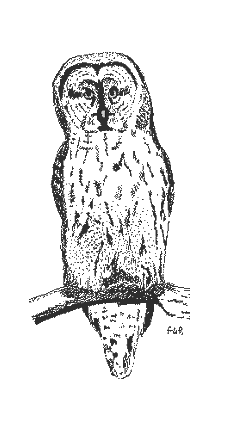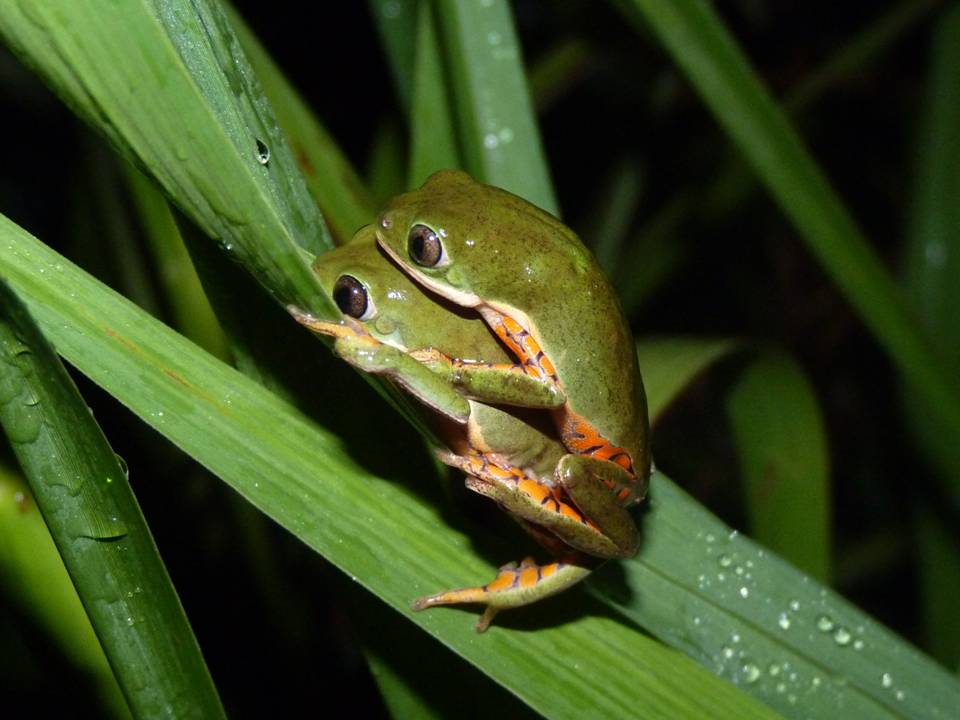Designed by Paul Smith 2006. This website is copyrighted by law.
Material contained herewith may not be used without the prior written permission of FAUNA Paraguay.
Photographs on this web-site were taken by Myriam Velázquez and Paul Smith and are used with permission.
ATLANTIC FOREST ODYSSEY TOUR
Introduction:
Officially the most threatened habitat type on earth, the Alto Paraná lowland Atlantic Forest of Paraguay is a must see for anybody with a serious interest in wildlife. As anybody who has ever visited tropical forests before will know, the more time you spend there, the more you will see. Fortunately the five Atlantic Forest sites on this tour offer the traveller the opportunity to revel in the sheer diversity of the wildlife that inhabits it, from gaudy toucans and parrots, to electric butterflies, skulking mammals and a cacophany of frogs. This tour promises lifelong memories.
Spot-billed Toucanet (right) Selenidera maculirostris
FAUNA Paraguay tours are recommended by:
FAUNA Paraguay eco-tours are promoted by:
|
|
|
|
 |
Birdfinders |
|
Main Targets:
The amazing diversity of the Atlantic Forest makes it difficult to pick the most worthy targets, but we will focus mainly on the 80 or so species considered endemic to the Atlantic Forest. Trogons, toucans, parrots and tanagers are always popular, while antbirds and forest furnariids reward the patient. At Carapá our main target will be the endangered Vinaceous Amazon. Serious birders will also be aiming to tick off the Atlantic Forest endemic species, amongst them the vulnerable Helmeted Woodpecker, Bare-throated Bellbird and Russet-winged Spadebill and the near threatened Blackish-blue Seedeater and Creamy-bellied Gnatcatcher.
Recommended duration:
To get the best from this tour we suggest at least 11 days, preferably more. A minimum of 8 days is required to complete it.
Best time to visit:
This tour is available year round. The "rainy season" is from October to November when mud can occasionally be a problem and there are more insects around. However this is also the best time of year for reptiles and amphibians, and the arrival of migrants of birds.
Itinerary:
Day 1 - Early visit to Arroyos y Esteros and continue to Itabó Rivas.
Day 2 - All day birding and wildlife-watching at Itabó Rivas. Night walk.
Day 3 - Continue to Itabó Itaipú.
Day 4 - All day birding and wildlife-watching at Itabó Itaipú. Night walk.
Day 5 - Continue to Salto del Guairá and visit to Carapá.
Day 6 - Return Ciudad del Este and visit to Salto del Monday.
Day 7 - Continue to Hotel Tirol, birding afternoon.
Day 8 - Morning birding at Hotel Tirol, continue to San Rafael after lunch.
Day 9 - All day birding at San Rafael. Night walk.
Day 10 - All day birding at Estancia Kanguery.
Day 11 - Return to Asunción and end of services.
(Itineraries are subject to change according to levels of animal activity or client´s preference.)
What else might we see?:
We begin our trip in Asunción and en route to Itabo Rivas we´ll make a stop over at Arroyos and Esteros, a great place to observe the charismatic but highly-threatened Strange-tailed Tyrant. There a host of other wetland birds here too, Maguari Stork, countless herons, Rusty-collared and Tawny-bellied Seedeaters, Crested Doradito, Long-tailed Reedfinch, Lesser Grassfinch, Limpkin and many more.
Our first Atlantic Forest destination is the fabulously unspoil Itabó Rivas. Great stands of giant bamboo here make for a dramatic setting and the birding is superb. The possibilities here are endless, with Atlantic Forest endemic species such as Chestnut-headed Tanager, Red-breasted Toucan, Spot-billed Toucanet, Slaty-breasted Wood-rail, Buff-bellied Puffbird, Ruby-crowned Tanager, Drab-breasted Bamboo-tyrant, Bay-ringed and Greenish Tyrannulet, Eared Pygmy-tyrant, Greenish Schiffornis etc etc. Mammal watching requires patience but may bring rewards. Bush Dog is here, but Azara´s Agouti and Crab-eating Fox are usually easier to see. Black-banded Owl and Black-capped Screech-owl are amongst the nightbirds we may see, with Ocellated Poorwill and Silky-tailed Nightjar requiring a touch of luck.
At Carapá we will haave the endangered Vinaceous Amazon as our main target - it is worth the drive. The extraordinary Horned Screamer is also a possibility in this area, as is White-wedged Piculet, this being the only known site in Paraguay where the species occurs. A visit to Salto del Monday waterfall is for the magnificent dusk spectacle of the swifts coming to roost. Gathering like a storm cloud above our heads as the sun begins to go down, huge numbers of Great Dusky, Sooty and sometimes White-collared Swifts then fire themselves torpedo-like, one by one to their roosting places on the slippery rocks behind the falls. Its a truly spectacular sight.
Popular with the king of Spain, Hotel Tirol has a dramatic setting in a lush forested gorge that makes for some great easy birding without straying too far from the hotel bar. At Tirol we will look for Blue and Band-tailed Manakin, Red-ruffed Fruitcrow, White-eyed Foliage-gleaner, Thrush-like and Lesser Woodcreeper, Grey-bellied Spinetail, Rufous-winged Antwren, Southern Antpipit, Ochre-faced Tody-flycatcher, Rufous Gnateater and Surucua Trogon amongst others. Oddly there are no parrots here, but the canopy flocks of feathered jewels such as Chestnut-bellied and Purple-throated Euphonia, Tropical Parula, Swallow-tanager and Blue Dacnis more than make up for that. Check the skies for Sick´s Swift and the localised Short-tailed Hawk. After dark we may get lucky with Tropical Screech-owl or even the fabulous Tawny-browed Owl, whilst at the right times of year Short-tailed Nighthawk should be flitting around our heads at dusk.
From here it is on to our final site, San Rafael National Park, officially the most biodiverse location in Paraguay. You could easily spend a week here and still be ticking off new birds. We might see Yellow-fronted, Helmeted, Robust and White Woodpecker, Ochre-collared Piculet, Magpie Tanager, Black-tailed and Black-crowned Tityra, Spot-backed Antshrike, Dusky-tailed Antbird, Three-striped Flycatcher, Greater Ani, Buff-fronted and Black-capped Foliage-gleaner, Rufous-capped Spinetail, Plovercrest, Scale-throated Hermit, as well as the globally-threatened Saffron Toucanet, Blackish-blue Seedeater, Creamy-bellied Gnatcatcher and Russet-winged Spadebill. I could go on and on. After dark mammals might include Capybara, Spotted Paca or even a Little Spotted Cat. Rusty-barred Owl is a speciality here, and Grey Potoo, Common Nighthawk, Pauraque and Rufous Nightjar are also possibilities.
San Rafael is also famous for the huge diversity of frog species that occur here, with over 30 species being recorded including Moustached, Ocellated and Speckled-bellied Frog, as well as Lesser Escuerzo, Purple-barred, Blacksmith and Rinky-dink Tree-frogs and many more.
Our last day will be spent at Estancia Kanguery where the extensive grasslands bring a whole host of new possibilities including the globally-threatened Saffron-cowled Blackbird, Sharp-tailed and Cock-tailed Tyrant and Ochre-breasted Pipit. During the spring migration endangered Marsh Seedeater and vulnerable Chestnut Seedeater often join the flocks of more numerous Capped Seedeater. Other local specialities include Lesser Grassfinch, Sedge Wren and Giant Snipe. There is some good forest here which might turn up Uniform Finch, Southern Bristle-tyrant and even Solitary Tinamou.

What does it include?:
The price includes pick-up from and return to Asunción hotel, accommodation, transport, food, non-alcoholic drinks and guiding fees.
It does not include travel insurance, personal expenses, alcoholic drinks or travel costs incurred before the beginning of the tour or after return to Asunción.
For further information or to book your tour email us at faunaparaguay@yahoo.com.ar
Ask about off-season discounts (15 Feb-15 July).
Earless Leaf Frog Phyllomedusa azurea



